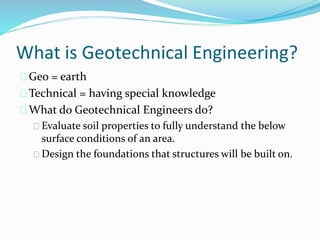Getting The Geotheta To Work
Getting The Geotheta To Work
Blog Article
Geotheta - The Facts
Table of ContentsAn Unbiased View of Geotheta5 Easy Facts About Geotheta ExplainedGetting The Geotheta To WorkGeotheta Fundamentals Explained
They work together with civil designers, structural designers, engineers, and other experts to integrate geotechnical considerations into the overall task layout and building process. This requires effective teamwork, coordination, and interaction to guarantee that the geotechnical elements line up with the project purposes and satisfy regulative requirements.Mining & Materials Engineering: Concepts of boring, infiltration rates, and variables impacting the choice of exploration technique. Blasting methods in surface and below ground functions. Mechanical and continual approaches to fragmentation, including longwall shearing and fullface boring.
Integrated evaluation of fragmentation and comminution procedures. Used by: Mining & Materials Design.
Geotheta Can Be Fun For Anyone
Bachelor's level programs in civil, geotechnical, geological, and environmental engineering commonly last four years and include general education and learning training courses in English, social scientific research, and the humanities, along with programs in sophisticated maths, architectural geology, and liquid mineralogy. (https://www.easel.ly/browserEasel/14498559)
Geotechnical engineering entails the assessment of the soil and rock problems at a particular website, and their implications for the advancement of that website. As many structures count on the ground for support, it lacks shock that a detailed understanding of the ground problems, and the suitability of structure systems, are essential to the long-term stability and performance of the structure or structure.
Specialising in the investigation of geological developments and ground behaviour, geotechnical engineers perform scientific examinations and screening to understand the impact these geological formations might carry the layout and building and construction of building, civil and framework jobs. This proficiency is vital for the layout and construction of buildings, roads, passages, dams, bridges, and water and sewage systems.
The geotechnical team at Douglas Partners routinely consult with designers, style designers, designers, and home builders to make referrals on layout and development proposals to ensure that the built frameworks are accordingly made for the ground problems. The design of footing systems requires to think about the weight of the structure, the ability of the ground to sustain that weight with each other with motion tolerances and reliable building.
Some Known Questions About Geotheta.
This task is substantially simplified by the use of our Douglas Map geospatial platform that makes this info readily available in an easy to utilize web browser interface. A geotechnical designer will direct the boring of boreholes and test pits to gather dirt and various other samples, and additionally examine surface area functions and ground direct exposures to develop a geotechnical version of the subsurface conditions.
Depending on the job kind and ground problems encountered, lab screening might among various other things analyze strength, compressibility, reactivity and/or permeability of dirt and rock examples. After this data is gathered and collated, the results are utilized for a geotechnical version of click to find out more the site, which is commonly offered as areas across the site.

A geotechnical investigation naturally can just examine the ground problems at the locations drilled or dug deep into. All-natural variations in soil and rock problems can take place throughout a site and in between examination areas. It is consequently good method that the geotechnical engineer be retained throughout building of the job to give on-site confirmation that the ground conditions experienced are constant with the expectations and recommendations given in the geotechnical investigation report.
Geotheta - An Overview
Geotechnical engineers utilize their comprehensive expertise of soil and rock to examine danger and resolve issues on diverse framework projectsGeotechnical design is a specialist branch of civil design which checks out the behavior of earth materials and the application of dirt and rock auto mechanics. Geo Tech Engineering. As a geotechnical engineer, you will certainly assess the physical, mechanical and chemical homes of soil and rock in order to design structures, maintaining frameworks and earthworks
Geotechnical engineering is closely linked to and overlaps with, both design geology and ground engineering - https://flossy-rotate-3d1.notion.site/Why-Geotechnical-Engineers-are-Vital-for-Your-Construction-Projects-7c147cf012a34d1abe5134afbabc811f?pvs=4. It's possible to specialise in geotechnics or job for a geotechnical firm but be referred to as an engineering geologist or a ground designer. As a geotechnical designer, you'll need to: build and preserve connections with clients and various other professionals involved in the site, throughout each projectmaintain security requirements on site be conscious of expense ramifications when you make recommendationsstudy geological maps and aerial photographs from a variety of resources and from different time periodsexamine construction intends to see exactly how possible they are based upon your understanding of the siteinvestigate risks or geological hazards for the sitesearch for eco sensitive attributes, such as garbage dump start to create factual and expository ground modelsplan field investigationsdrill and evaluate samples of bedrock, dirt, groundwater and extra products monitor various other experts on sitesolve technical concerns as they occur, such as unforeseen structures at drill sitesmonitor problems throughout and after building and construction to make certain structures are steady in the short and lengthy termadding data accumulated on site to your initial researchcreating geotechnical computations, drawings, and two or three-dimensional computer system models analyzing the datamaking referrals regarding the suggested usage of the site

Report this page